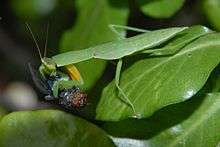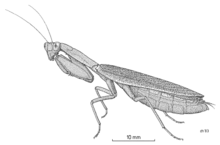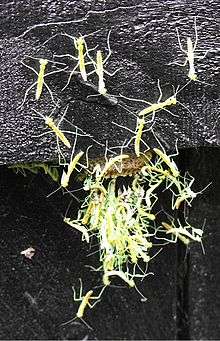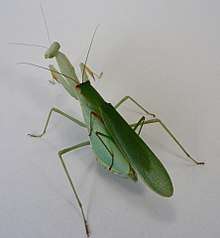Orthodera novaezealandiae
Orthodera novaezealandiae, known as the New Zealand mantis or the New Zealand praying mantis, is a species of praying mantis which is, as both the scientific name and common names suggest, indigenous and endemic to New Zealand.[1][2][3][4][5]
| Orthodera novaezealandiae | |
|---|---|
_from_side.jpg) | |
| Scientific classification | |
| Kingdom: | |
| Phylum: | |
| Class: | |
| Superorder: | |
| Order: | |
| Family: | |
| Genus: | |
| Species: | O. novaezealandiae |
| Binomial name | |
| Orthodera novaezealandiae (Colenso, 1882) | |
Description
_from_above.jpg)
O. novaezealandiae nymphs are pale, translucent green with a dark stripe running from head to end of abdomen. As adults, they are bright green and grow to between 35 mm and 40 mm in length.[5](see note [6]) As in most mantis species, sexual dimorphism means the female is larger.[3][5]
The New Zealand mantis has a triangular head with slightly oversized compound eyes that give it excellent binocular vision (although they do have a blind spot). Its wings differ from those of other species in the "development of the archedictyon and the absence of cross-veins in the forewing".[3][5]
"A very active little Mantis",[5] O. novaezealandiae is well adapted as a predator. Its specialized forelimbs are long and equipped with extremely sharp spikes to trap prey.[3] Blue eyespots on the underside of the insect's forelegs helps in differentiating this species from Miomantis caffra, an introduced species from South Africa that became established in New Zealand during the 1970s.[1][4][7]
The ootheca of the New Zealand mantis has eggs arranged in two rows, quite different from the messier egg mass of Miomantis caffra. Oothecae are generally arranged facing north towards the sun, on the warm faces of branches and tree trunks.[8]
Ecology

O. novaezealandiae prefer open, shrubby terrain where its similarity to leafy vegetation may be used as camouflage to ambush prey. It can reach high numbers in the branches of small manuka and kanuka trees in open meadow-like habitats where grass-dwelling prey such as small moths are abundant. It hides well from predators and is near or at the top of the invertebrate food chain in its habitat. As an endemic species of New Zealand that eats pests and has a very large appetite, O. novaezealandiae is a beneficial insect to those involved in agriculture and they are used in many gardens.[3][9]
The New Zealand mantis is vulnerable to the use of pesticides, both directly and through the effects of a diminished food supply, and their ootheca are sometimes attacked by parasitic wasps.[3][10] Male O.novaezealandiae appear to be attracted to females of the introduced species M. caffra, which can result in their fatality due to the sexually-cannibalistic behavior of the latter species.[11]
The only two species of mantis in New Zealand are this native species and the previously-mentioned introduced species M. caffra discovered as established in the Auckland suburb of New Lynn in 1978. O. novaezealandiae is taxonomically very close to, and has sometimes been considered conspecific and synonymous with, the Australian species O. ministralis.[1][2]

Cultivation
_laying_eggs.jpg)
The New Zealand mantis is bred in captivity.[5][12] Special care must be taken to prevent this small, quick-moving species from escaping. Nymphs are especially fast and can leap relatively far as well. It can be kept at room temperature (25–30 °C or 77–86 °F) but does prefer warmth. Their enclosure should be sprayed with water a few times a week, and when they are young their enclosure should be kept at around 50%–60% humidity. Captive O. novaezealandiae can be fed on a diet of small crickets and flies.[5] Nymphs can be reared easily on fruitflies such as Drosophila melanogaster.

See also
References
- University of Auckland
- Ramsay, G. W. 1990. Mantodea (Insecta) with a review of aspects of functional morphology and biology. Fauna of New Zealand 19, 96 pages. ISBN 0-477-02581-1. Published 13 June 1990.
- Purkayastha, M. 1999, Orthodera novaezealandiae, University of Michigan Animal Diversity Web. Accessed July 27, 2008
- Tree of Life
- New Zealand Praying Mantis (exotic-pets.co.uk)
- This information from the University of Michigan reports that O. novaezealandiae grows between 3.5 and 4.5 inches in length, a size that seems incompatible with the information given in other sources. 3.5 to 4.5 centimetres may be what the text should read.
- Photo of O. novaezealandiae female creating ootheca and discussion of Miomantis caffra
- Bowie, Matthew K.; Bowie, Mike K. (2003). "Where does the New Zealand praying mantis, Orthodera novaezealandiae (Colenso) (Mantodea: Mantidae), deposit its oothecae?". New Zealand Entomologist. 26: 3–5. doi:10.1080/00779962.2003.9722103. hdl:10182/3035.
- Rimutaka Forest Park, New Zealand
- Praying Mantids in the Brisbane area, Queensland, Australia
- Fea, Stanley, Holwell (2013). "Fatal attraction: sexually cannibalistic invaders attract naive native mantids". Biology Letters. 9 (6): 20130746. doi:10.1098/rsbl.2013.0746. PMC 3871360. PMID 24284560 – via Royal Society Publishing.CS1 maint: multiple names: authors list (link)
- Species Database: Mantodea

Bibliography
- Ramsay, G.W., Fauna of New Zealand Number 19 Wellington, N.Z.: DSIR Publishing, 1990.
- Patterson, Kathleen, J, "The Praying Mantis", Conservationist, June 193 v47 n6 p30(6).
- Preston-Mafham, Ken, Grasshoppers and Mantids of the World London, UK.:Blandford 1990.
External links
| Wikimedia Commons has media related to Orthodera novaezealandiae. |
- Orthodera novaezealandiae bibliography from the New Zealand Entomological Society
- Discussed on RNZ Critter of the Week, 27 May 2016
- Article in T.E.R:R.A.I.N.: "Praying mantis (NZ)"
- Picture in Te Ara: "Eating a spider"